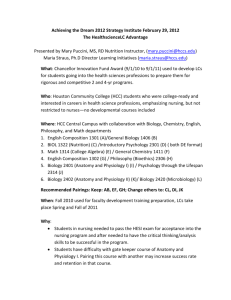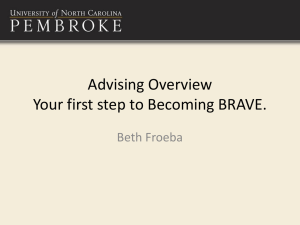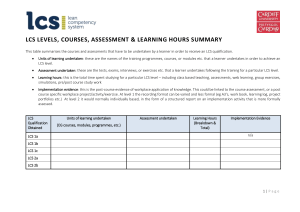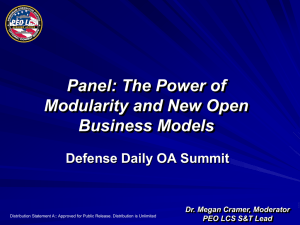HealthscienceLC_Advantage_Creating_Learning
advertisement
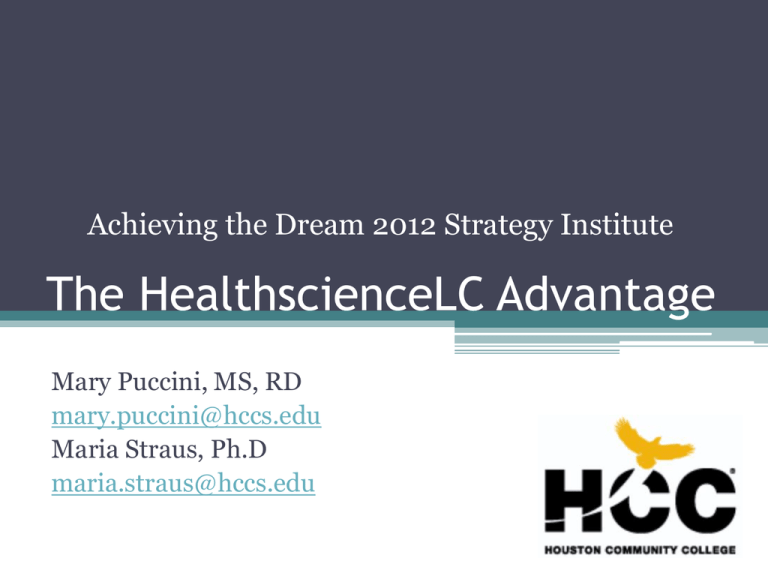
Achieving the Dream 2012 Strategy Institute The HealthscienceLC Advantage Mary Puccini, MS, RD mary.puccini@hccs.edu Maria Straus, Ph.D maria.straus@hccs.edu The who, what, where, when, why and how of making a learning community for those in the health sciences field. Chancellor Innovation Fund Award (9/1/10 to 9/1/11) used to develop LCs for students going into the health sciences professions to prepare them for rigorous and competitive 2 and 4-yr programs. LC definition • A group of students who are co-enrolled in two or more courses linked by a common theme. Attributes of an LC • Increase retention—fewer withdrawals within the semester and more students registering for following semester • Increase success/learning—more As, Bs, Cs • Increase collaborative learning—more group work—”class continues even after class”-Tinto • Relate learning to real-world issues • Connect concepts from different disciplines Types of LCs • Level One—students are co-enrolled • Level Two—courses taught back-to-back, some common content is stressed • Level Three—instructors collaborate on integrative assignments that pull from both disciplines • Level Four—common syllabi aligning content, joint projects cover an overarching theme Where to start—several approaches • What’s been done before either at your institution or in the literature • What courses do students historically take together • What are you personally interested in and/or have found a partner to pair with • What are the “curricular trouble spots”* that you want to address HCC students who were college-ready and interested in careers in health science professions, emphasizing nursing, but not restricted to nurses—no developmental courses included HCC Central Campus with collaboration with Biology, Chemistry, English, Philosophy, and Math departments Fall 2010 used for faculty development training preparation, LCs take place Spring and Fall of 2011 •Improve understanding of Anatomy and Physiology I, a gate keeper course, for health sciences. •Improve the pass rate for the HESI exam for acceptance into the nursing program •Give an advantage to HCC Students for program admission. •Improve critical thinking/analysis skills to be successful in the program. For faculty We used one semester to: • Attend a workshop given by Kingsborough College trainers • Decide which courses to pair • Develop integrated assignments and LC theme • Create a web site • Advertise the new program Courses Linked • English Composition 1301/General Biology 1406 • Biology 1322 (Introductory Nutrition)/Introductory Psychology 2301 (DE format) • Math 1314 (College Algebra)/ General Chemistry 1411 • English Composition 1302/ Philosophy (Bioethics) 2306 • Biology 2401 (Anatomy and Physiology I)/ Psychology through the Lifespan 2314 • Biology 2402 (Anatomy and Physiology II)/ Biology 2420 (Microbiology) Determining which courses to pair: • Identify curricular trouble spots by asking: What do students need to know deeply and be able to do in order to handle unscripted situations in their profession? Emily Lardner, Evergreen College Stumbling blocks • In your discipline? An example—Anatomy and Physiology I is the stumbling block for those in biology or health science field • In your course? The concept of homeostasis— how the body tries to maintain equilibrium—is the stumbling block for those within biology courses Determine your LC theme • You may want to use the curricular trouble spot for the theme. For example: Homeostasis may be presented as “The Great Balancing Act.” • If possible, it’s nice to have a catchy title to pique student interest in this new way of learning. Developing the LCs continued • Exchange SLOs • Place textbooks side-by-side and go through the content to identify areas for integration and for areas that address curricular trouble spots • Place syllabi side-by-side and see where material can be shifted to match what is taught in paired courses Real life experiences/ Problem based learning/InquiryBased Projects Develop integrated assignments and their grading rubrics. • Does the assignment pass the “Scissor test”? • Does it apply to real life experiences? Examples of Real Life Experiences • National Center for Case Studies Teaching in Science (http://sciencecases.lib.buffalo.edu/cs) • Math problems related to a construction project • Chemistry problems related to household cleaners • Grammar mistakes which change the meaning of sentences. These can be found especially in online newspaper or magazine articles. • Health claims on food labels. Real life experiences • Include examples from newspapers, articles, advertisements, food labels or products…issues that require critical thinking that can be used for classroom discussion. • Build on the critical thinking skills you have modeled in the classroom to have students do group projects that require research and analysis that is beyond the scope of what can be done in the classroom. Nutrition Text/Psychology Text/Topic/Integrated Assignment Chapter 3: Digestion: From Meals to Molecules Chapter 5: Learning Classical conditioning and digestive function Chapter 4: Carbohydrates: Sugars, Starches, and Fibers Chapter 13: Personality Theory and Assessment Big Five personality traits and health outcomes Chapter 5: Lipids: Fats, Phospholipids, and Sterols Chapter 14: Psychological Disorders Nutritional hypotheses that involve dietary fats Chapter 6: Proteins and Amino Acids Chapter 2: Biology and Behavior Proteins and neurotransmitter function Developed by Denise Boyd, Ph.D Your textbook describes the process through which the pancreas becomes classically conditioned to respond to sweet tastes. Use the internet to find other digestive functions that are influenced by classical conditioning. In what ways might classical conditioning contribute to both good and poor dietary habits? Your textbook notes a connection between conscientiousness and obesity. Use the internet to find other correlations between Big Five traits and health outcomes. Propose an explanation for each correlation you find. Many books and websites tout omega-3 supplements as effective for the treatment of depression. Use the internet to research this claim. If you had depression, would you take omega-3 supplements? Why or why not? People with eating disorders such as anorexia and bulimia often have deficiencies of the protein tryptophan. Use the internet to find out about the emotional consequences of this deficiency and how it complicates the treatment of eating disorders. Because of the complex physiology of eating disorders, many experts recommend tube feeding or parenteral nutrition to restore patients to normal physiological functioning so that they will be emotionally capable of responding to psychotherapy. Take a position for or against forced feeding of people with eating disorders and explain your reasons. Developing the LCs continued • Develop some group projects that force students to collaborate. Devote class time for students to work on them. • Provide for a communication vehicle within the course—web-enhanced courses have built-in email and discussion tools To cement the learning that took place in doing the projects, have students give a presentation or take a survey of the issue with friends and neighbors. In this way, they will have to explain the project and its findings to others. For students Counseling and Advisors— These are the people who can help fill your classes ▫ Give them the information and materials they need to explain LCs to students ▫ Have them work with testing services to direct students to advisors for degree plans/registration ▫ Use them in the classroom—intrusive counseling— on the first day and throughout the semester. Counselors could schedule a session when there may be extra time during class (end of a lab session for lab courses or after a test for lecture courses). Try everything! Advertising • Create a web site using a “vanity” URL (example: hccs.edu/healthscienceLC) that is easily remembered ▫ Explain the program advantages ▫ Include courses linked, common themes, faculty teaching, semester specific section numbers ▫ Include a video of the program, if possible Advertising continued • Make posters and place around campus • Make student-developed (3’ X 4’) posters of integrative assignments and place in hallways • Have faculty teaching give “live commercials” in the classes that feed into LC courses Advertising Continued • “Work” registration—hang out at the areas where students are waiting to talk to counselors and financial aid • Have a video running as a continuous loop in areas where students are waiting Assessment • Do the Online Survey of Students' Experiences of Learning in Learning Communities survey by Skagit Valley (mpettitt@skagit.edu; 360-416-7919) that tracks with CCSSE data • Consider integrative assignment—did it achieve objectives? • Did students collaborate in and out of class Debriefing at end of semester • Meet with all LC faculty and allow time for sharing of what worked and didn’t work • Have pairs decide what to change—eliminate, add or tweak—for next semester If there is no formal faculty development time allotted to this task, you could use the lunch time of general meetings of your whole college. At HCC , each college has a convocation twice yearly. Conferences available • Summer Institute of the Washington Center for improving the quality of undergraduate education (www.evergreen.edu/washcenter) • National Learning Communities Conference at Harper College (goforward.harpercollege.edu search for Learning Community conference) • The Atlantic Center for Learning Communities (www.wagner.edu/aclc ) Reward students in LC program • If they successfully participate in three LCs, they will get a note on their transcript. • Have a recognition of achievement lunch/dinner/ceremony for those who complete an LC and recognize those who have completed three. Questions?
